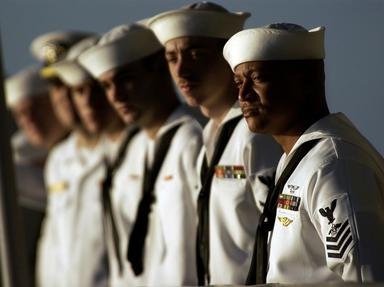Quiz Answer Key and Fun Facts
1. This ship ended up with her non-commissioned sister's bow. This would lead to a nickname that would reflect both ships and give the abbreviations of two states. Her nickname is WisKY - but what is her real name?
2. A veteran of WWI, she'd earn the nickname "Chesapeake Raider" during WWII because of where she would primarily operate. After WWII, newly-graduated from Annapolis Ensign James Earl "Jimmy" Carter, Jr. would join her crew. Which ship is this?
3. Her class would be built following the Second London Conference. During WWII she would take part in Operation Torch where she would damage the Vichy French battleship Jean Bart. Her nickname is "Big Mamie" - which ship is she?
4. She would be the only battleship to get underway during the attack on Pearl Harbor, and if her captain hadn't grounded her at Hospital Point she might have closed the harbor for months. Known as the "Cheer Up Ship", her real name is what?
5. She was the lead ship of the class that included USS Arizona. Her nickname was "Pennsy" - so what was her real name?
6. This battleship was named for a state that was once going to be known as Kanawha after it seceded from another state. What is the real name of the "Wee Vee"?
7. She was the first fast battleship built by the US, but her nickname came from the name of a popular Broadway musical, a book, and two movies. She is known as "Showboat", but what is her real name?
8. She was the only battleship in her class, one of two classes of Second Class battleships, and the first battleship to bear her name. More importantly, she was the first US battleship. What is the real name of "Old Hoodoo"?
9. She was the lead ship of the second class of fast battleships and would take part in the Battle of the Santa Cruz Islands and the Naval Battle of Guadalcanal. She is "Battleship X" - properly known as what?
10. At the start of the Spanish-American War BB-3 was the U.S.'s sole west coast battleship and was forced to make a journey around Cape Horn to join the four remaining U.S. battleships in the Atlantic. The trip would be cited as sweeping away all resistance to the construction of the Panama Canal. Known affectionately as "Bulldog of the Navy", what was her real name?
Source: Author
F6FHellcat
This quiz was reviewed by FunTrivia editor
stedman before going online.
Any errors found in FunTrivia content are routinely corrected through our feedback system.
